
Introduction
It does not matter what kind of project you run, there is always nice to have release notes. Collection of implemented user stories, features, and solved bugs. Of course, after each release, we can write these release notes manually but there is a better way to automate this process. In one of the projects together with the team, we use Azure DevOps together with Wiki as a source of information about the project. Why not use the project’s wiki to store release notes? In this article, I would like to present how to automate generating release notes for the project using Azure Functions and Azure DevOps.
The end result can be like presented below:

Wiki in the Azure DevOps
Let’s start with the Azure DevOps Wiki for the project. As you can see below, I published a Wiki as GIT repository:





Branching strategy and merges
In this specific scenario I used GIT flow branching strategy. Below diagram presents how releases to specific environments are mapped on branches from the GIT repository:
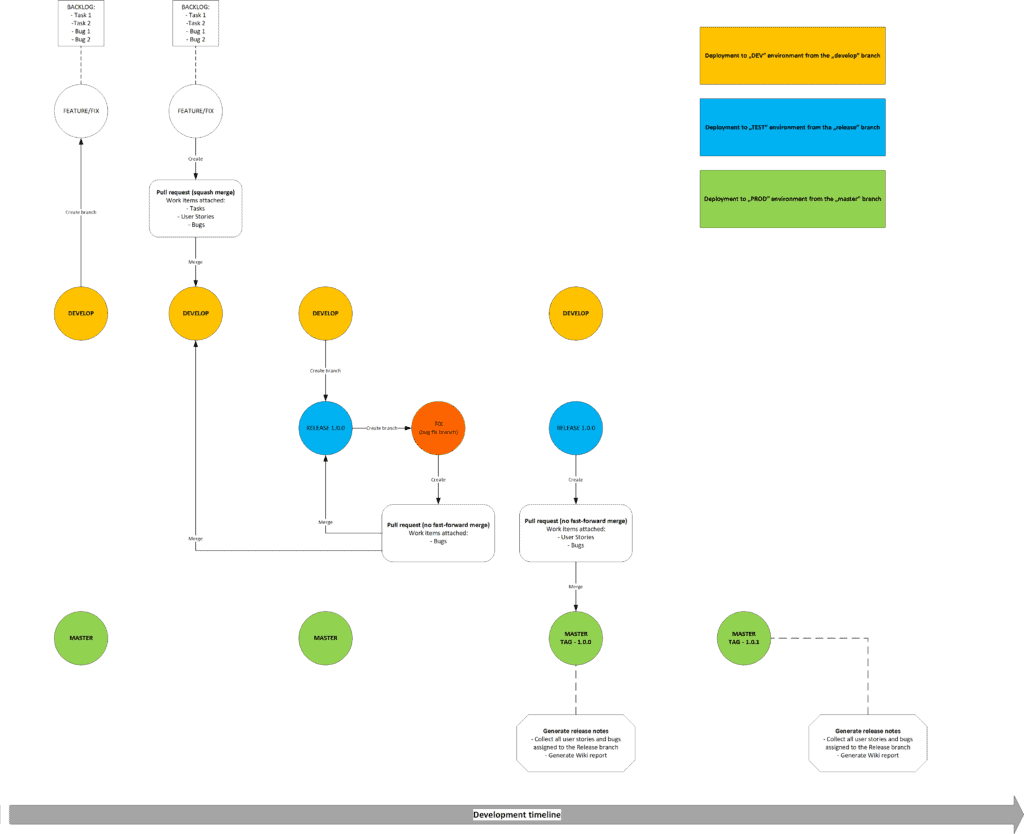
There are three environments used:
- DEV
- TEST
- PRODUCTION
At some point, there is release branch created with the name: release-1.0.0. After tests on the TEST environment, and solving the bugs, there is a pull request created to merge changes to the master branch and release packages on the PROD environment. After this merge, I want to have release notes generated in the Wiki of the Azure DevOps project.

Azure Function App responsibility
Azure Functions are perfect for the scenarios where we want to handle events – in this specific case we want to trigger Azure Function, once there is a successful merge to the master branch. This Azure Function uses Azure DevOps API to:
- Pull all User Stories and Bugs that were completed in the release (in this example release-1.0.0)
- Create release notes structure
- Publish release notes to the Azure DevOps project’s wiki

Let’s talk about implementation details. First of all, to communicate with the Azure DevOps API we need to obtaind Personal Access Token (PAT):

When creating new Personal Access Token, we have to indicate scopes so we can get information about work items from the backlog and gain access to modify project’s wiki pages:
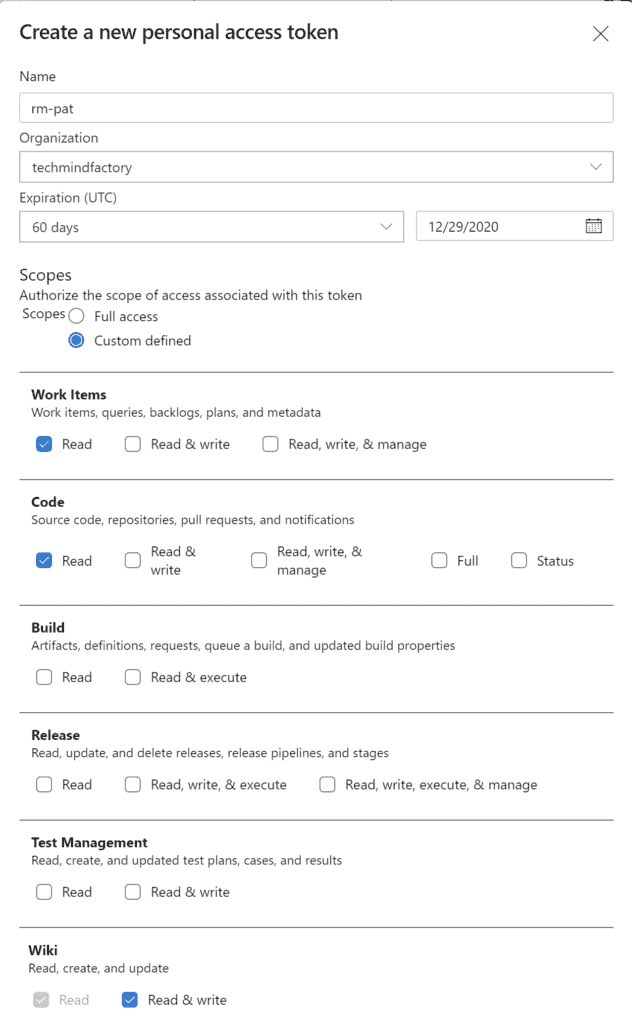
In the source code of the Function App, I use HttpClient to make calls to the Azure DevOps API. Authentication is done using PAT token in the Authorization header:
private void AuthenticateRequest()
{
_httpClient.DefaultRequestHeaders.Authorization = new AuthenticationHeaderValue("Basic",
Convert.ToBase64String(ASCIIEncoding.ASCII.GetBytes(
string.Format("{0}:{1}", "", _azureDevOpsConfiguration.PersonalAccessToken))));
}
Then I have created two methods, one to get user stories attached to the release and one to get resolved bugs:
private async Task<UserStoryDetails> GetUserStoryDetailsAsync(JObject pullRequestWorkItemDetails, string workItemUrl)
{
var fields = pullRequestWorkItemDetails["fields"];
var relations = pullRequestWorkItemDetails["relations"];
var userStoryId = pullRequestWorkItemDetails["id"].ToString();
var userStoryTitle = fields["System.Title"].ToString();
var userStoryDescription = fields["System.Description"].ToString();
var userStoryAcceptanceCriteria = fields["Microsoft.VSTS.Common.AcceptanceCriteria"].ToString();
var userStoryDetails = new UserStoryDetails()
{
Id = userStoryId,
Title = userStoryTitle,
Description = userStoryDescription,
AcceptanceCriteria = userStoryAcceptanceCriteria,
Url = workItemUrl
};
foreach (var relation in relations.Children())
{
if (relation["rel"].ToString() == "System.LinkTypes.Hierarchy-Reverse")
{
var parentUrl = relation["url"].ToString();
var parentDetailsResponse = await _httpClient.GetAsync(parentUrl);
var parentDetailsResponseAsString = await parentDetailsResponse.Content.ReadAsStringAsync();
JObject parentWorkItemDetails = JsonConvert.DeserializeObject<JObject>(parentDetailsResponseAsString);
var parentFields = parentWorkItemDetails["fields"];
var parentTitle = parentFields["System.Title"].ToString();
userStoryDetails.ParentFeatureTitle = parentTitle;
}
}
return userStoryDetails;
}
private async Task<BugDetails> GetBugDetailsAsync(JObject pullRequestWorkItemDetails, string workItemUrl)
{
var fields = pullRequestWorkItemDetails["fields"];
var bugId = pullRequestWorkItemDetails["id"].ToString();
var bugTtitle = fields["System.Title"].ToString();
var reproductionSteps = fields["Microsoft.VSTS.TCM.ReproSteps"].ToString();
var bugDetails = new BugDetails()
{
Id = bugId,
Title = bugTtitle,
ReproductionSteps = reproductionSteps,
Url = workItemUrl
};
var bugRelations = pullRequestWorkItemDetails["relations"];
foreach (var relation in bugRelations.Children())
{
if (relation["rel"].ToString() == "System.LinkTypes.Hierarchy-Reverse")
{
var parentUrl = relation["url"].ToString();
var parentDetailsResponse = await _httpClient.GetAsync(parentUrl);
var parentDetailsResponseAsString = await parentDetailsResponse.Content.ReadAsStringAsync();
JObject parentWorkItemDetails = JsonConvert.DeserializeObject<JObject>(parentDetailsResponseAsString);
var parentFields = parentWorkItemDetails["fields"];
var parentTitle = parentFields["System.Title"].ToString();
bugDetails.ParentUserStoryTitle = parentTitle;
}
}
return bugDetails;
}
Now to generate the release notes in the Wiki, I wrote below method:
private async Task UpdateWikiReleaseNotesAsync(ReleaseNotesReport releaseNotesReport)
{
StringBuilder sb = new StringBuilder();
sb.Append($"# {releaseNotesReport.ReleaseTitle}");
sb.Append("\n");
sb.Append($"## Release notes for the release: {releaseNotesReport.ReleaseVersion}\n");
sb.Append("\n");
sb.Append("## Repository name:\n");
sb.Append(releaseNotesReport.RepositoryName);
sb.Append("\n");
sb.Append("## User Stories completed:\n");
sb.Append("\n");
foreach (var userStory in releaseNotesReport.ReleaseWorkItems.UserStories)
{
sb.Append($"[{userStory.Title}](https://dev.azure.com/{_azureDevOpsConfiguration.Organization}/{_azureDevOpsConfiguration.Project}/_workitems/edit/{userStory.Id})");
sb.Append("\n");
sb.Append("\n");
}
sb.Append("\n");
sb.Append("## Bugs fixed:\n");
sb.Append("\n");
foreach (var bug in releaseNotesReport.ReleaseWorkItems.Bugs)
{
sb.Append($"[{bug.Title}](https://dev.azure.com/{_azureDevOpsConfiguration.Organization}/{_azureDevOpsConfiguration.Project}/_workitems/edit/{bug.Id})");
sb.Append("\n");
sb.Append("\n");
}
var wikiReleaseNotes = new WikiReleaseNotes()
{
Content = sb.ToString()
};
await _httpClient.PutAsJson($"https://dev.azure.com/{_azureDevOpsConfiguration.Organization}/{_azureDevOpsConfiguration.Project}/" +
$"_apis/wiki/wikis/{_azureDevOpsConfiguration.WikiId}/" +
$"pages?path=Releases/{releaseNotesReport.ReleaseVersion}" +
$"&versionDescriptor.version=master" +
$"&api-version={_azureDevOpsConfiguration.ApiVersion}", wikiReleaseNotes);
}
- Source code repository ID
- Pull request ID
[FunctionName(FunctionsRegistry.UipReleaseNotesFuncAppName)]
public async Task<IActionResult> RunAsync(
[HttpTrigger(AuthorizationLevel.Function, "post", Route = null)] HttpRequest req,
ILogger log)
{
log.LogInformation("C# HTTP trigger function processed a request.");
string requestBody = await new StreamReader(req.Body).ReadToEndAsync();
var pullRequestMergeEvent = JsonConvert.DeserializeObject<PullRequestMergeEvent>(requestBody);
if (pullRequestMergeEvent != null)
{
await _azureDevOpsService.GetPullRequestContentAsync(pullRequestMergeEvent.resource.repository.id,
pullRequestMergeEvent.resource.pullRequestId);
return new OkResult();
}
else
{
return new BadRequestResult();
}
}
Azure DevOps webhook
Once Azure Function App is published on the Azure cloud, we can setup web hook in the Azure DevOps to call it once there is successful merge from the release-1.0.0 branch to the master branch:

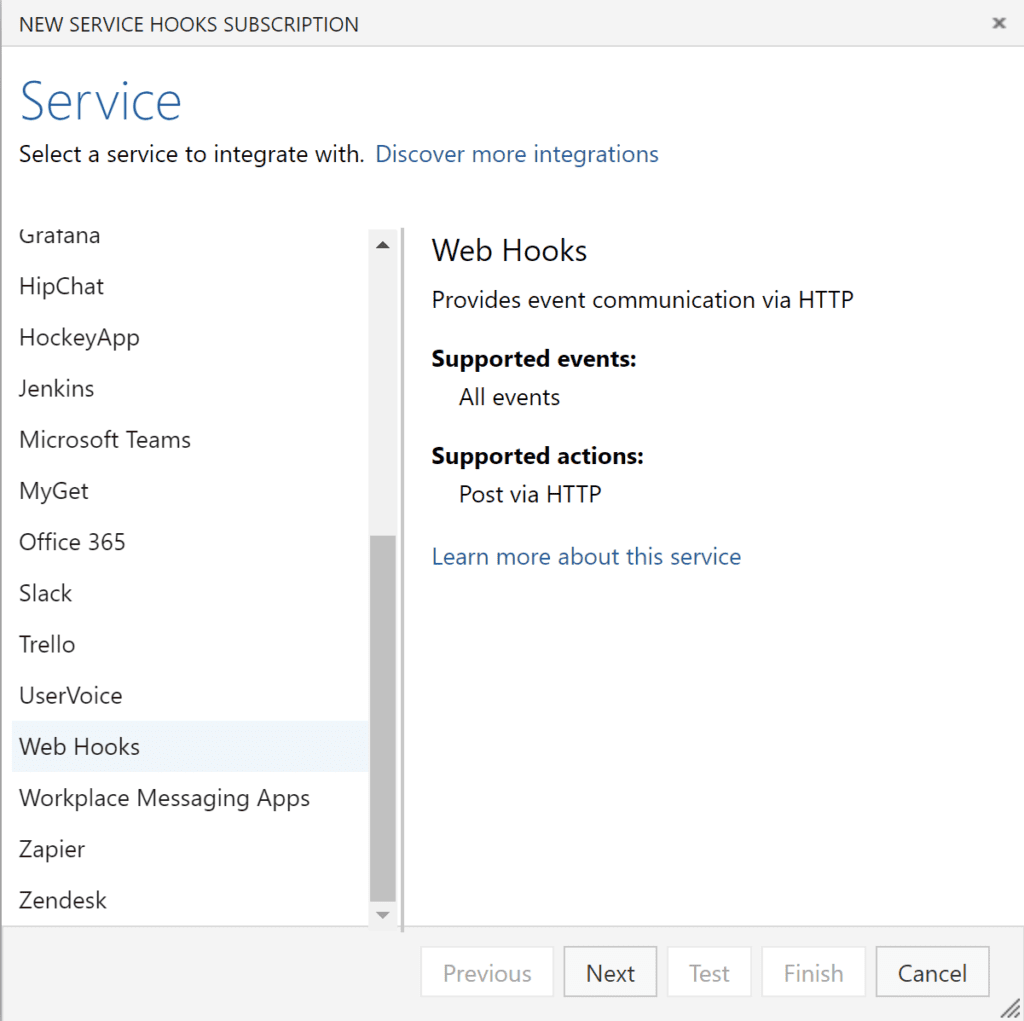
We can apply filters, in this case I set filter on the repository, branch and merge result to make sure that Azure Function is called only after successful merge to the master branch:
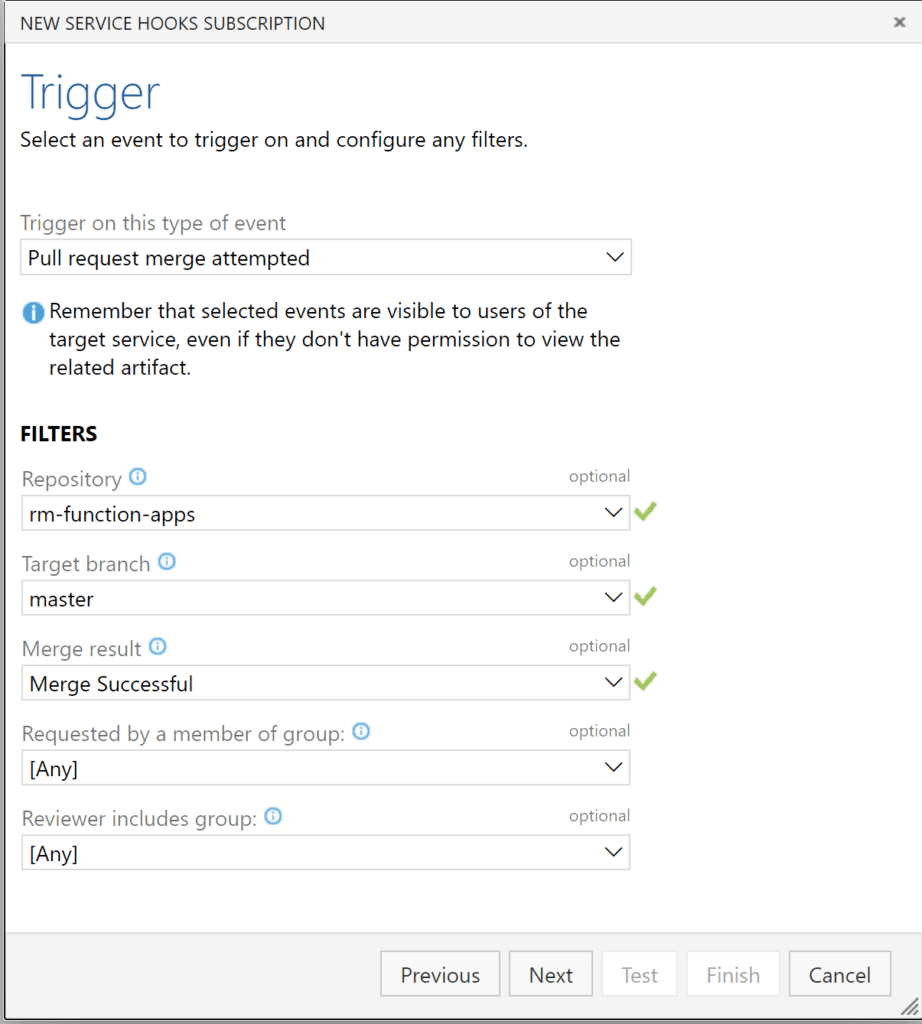
In the last step we have to provide the URL address of the Azure Function App (together with the code):
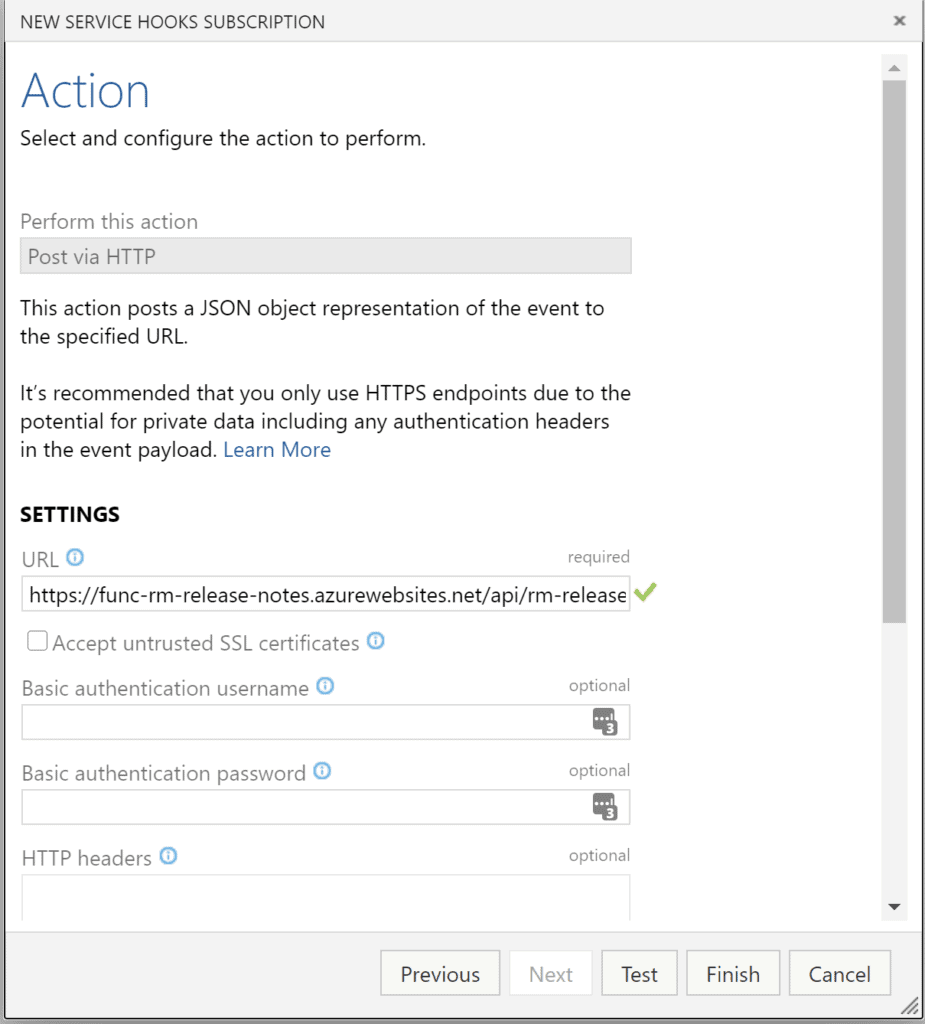
Final result
Below I presented the final result. Once pull request is completed, there is a merge to master branch and Function App is then triggered. All user stories and bugs are then listed in the Wiki:

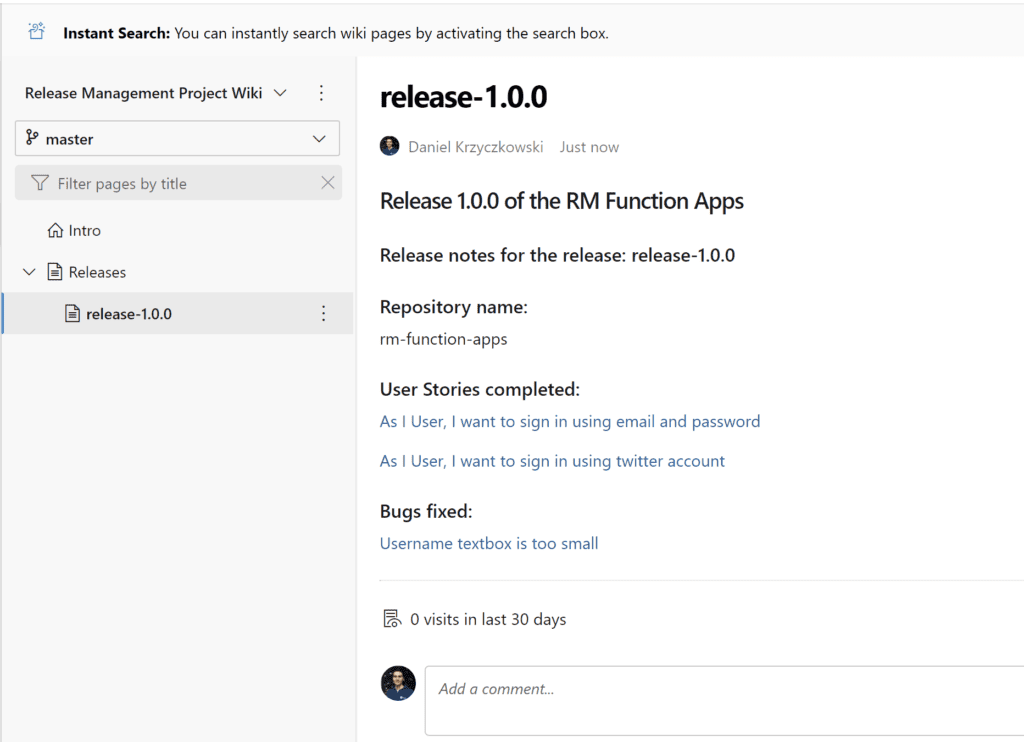
Summary
In this article, I presented the approach to automate generating release notes in the project’s wiki in the Azure DevOps using Azure Function Apps and webhooks. Of course, the whole process can be adjusted to many different scenarios – the main idea here is to show that without any special extensions we can achieve release notes.
Find more great content here!
About the Author:
Passionate about Microsoft technologies.
Awarded with Microsoft Most Valuable Professional title.
Main part of his activities is to share knowledge and passion about Microsoft Azure, DevOps, IoT and Universal Windows Platform.
Principal Software Engineer @ PredicaGroup.com
Pluralsight Author
Reference:
Krzyczkowski, D. (2020). Release notes with Azure Functions and Azure DevOps. Available at: https://daniel-krzyczkowski.github.io/Release-Notes-With-Azure-Functions-And-Azure-DevOps/ [Accessed: 21st January 2020].










